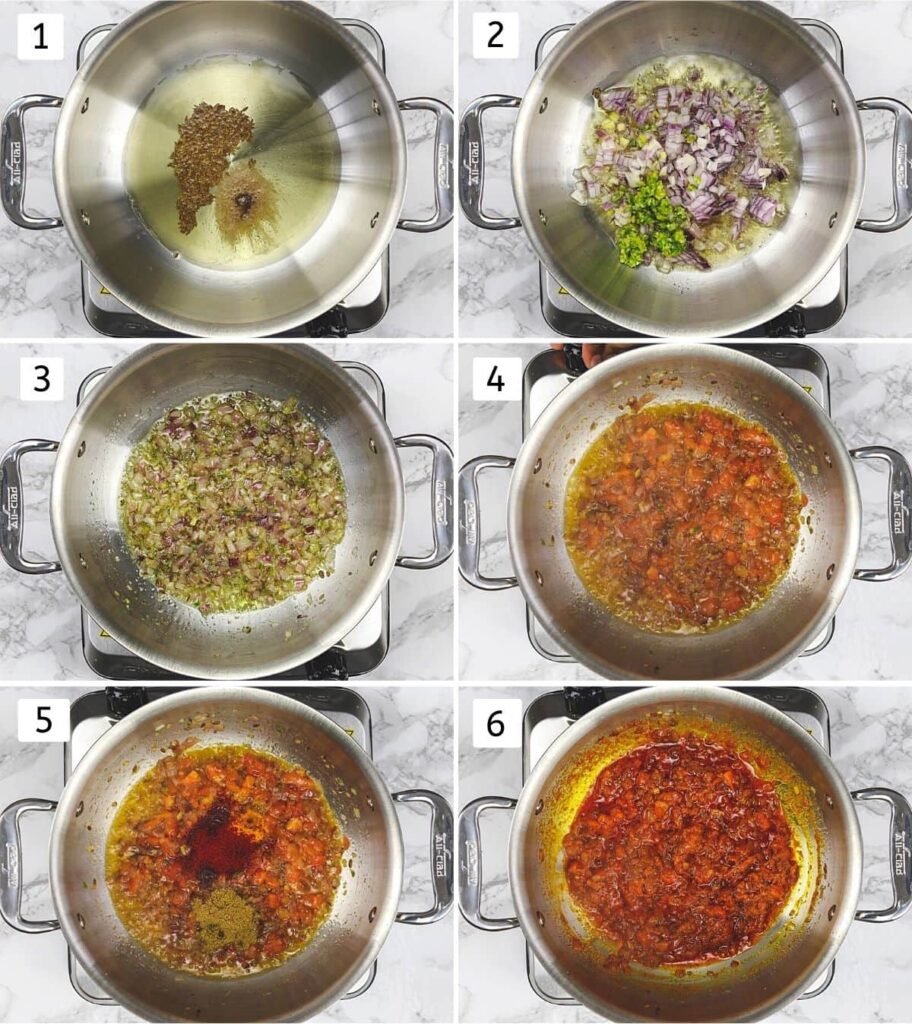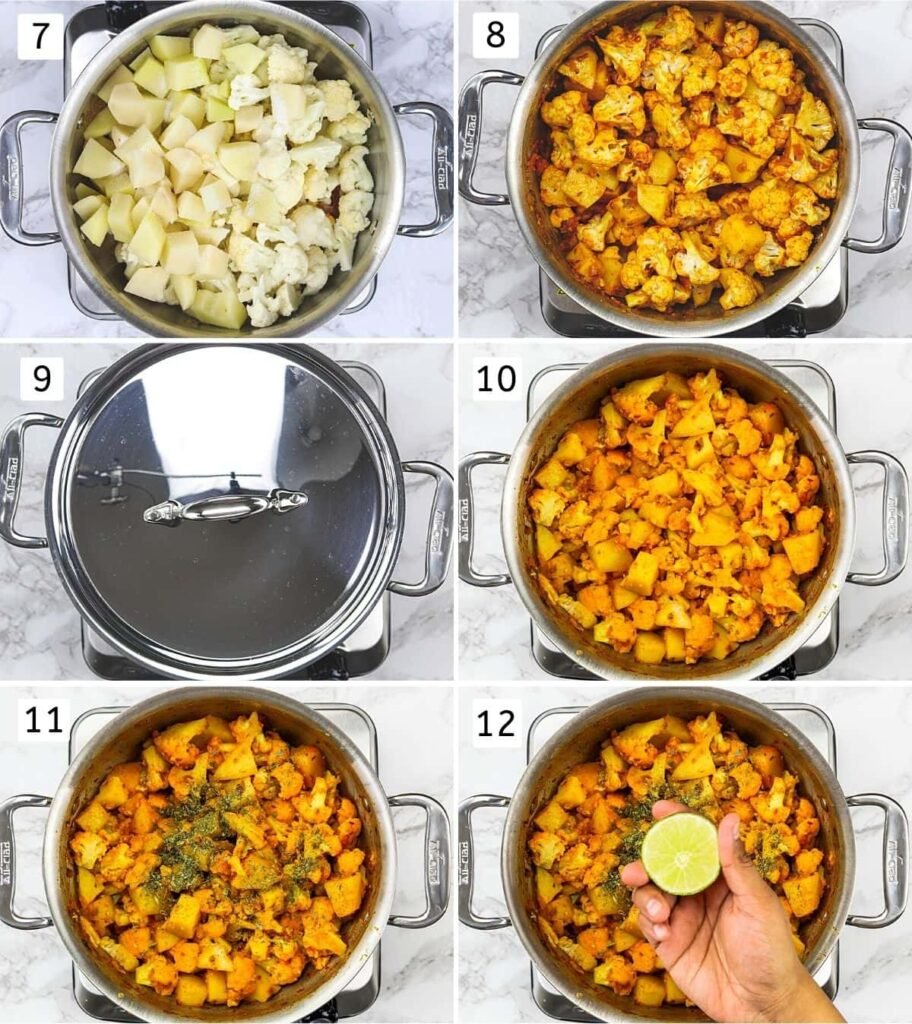Aloo Gobi is a beloved vegetarian dish from North India that brings together everyday ingredients like cauliflower and potatoes to create something truly flavorful and comforting. These two vegetables are simmered together in a flavorful, aromatic onion-tomato masala infused with traditional Indian spices like turmeric, cumin, coriander, and garam masala. The result is a hearty, soul-satisfying dish that bursts with earthy, mildly spicy, and tangy flavors in every bite.

This dish is incredibly versatile and comes together with simple ingredients, yet the taste is nothing short of restaurant-style comfort food. Whether you’re new to Indian cuisine or a seasoned home cook, Aloo Gobi is a must-make recipe that belongs in your weekly meal rotation.
Serve it hot with freshly made roti, paratha, or plain basmati rice for a wholesome Indian meal. Add a side of crunchy and refreshing kachumber salad (a mix of chopped cucumber, onion, tomato, lemon juice, and spices) or a dollop of plain yogurt to balance the warmth of the spices. A spoonful of pickle or a green chutney on the side can elevate the meal even further.
Whether you’re cooking for your family, hosting a vegetarian dinner, or meal-prepping for the week, Aloo Gobi is satisfying, nutritious, and packed with flavor. It’s naturally vegan, gluten-free, and can be made dry (sukhi sabzi) or semi-gravy style, depending on your preference.
You’ll Love This Aloo Gobi Recipe
This version of Aloo Gobi hails from North India, specifically the Punjabi style of cooking. In Hindi, we use the word ‘Aloo’ for potato, ‘Gobi’ for cauliflower, and ‘Masala’ to describe the spiced onion-tomato base used to simmer the vegetables. It’s a simple, comforting, and flavorful dish that can easily become part of your weekly meal routine.
A one-pan dish where veggies simmer in spiced onion-tomato masala—easy, flavorful, and perfect for busy weeknights.
Unlike the restaurant-style version, where potatoes and cauliflower are deep-fried before being tossed into the masala, this home-cooked method skips the heavy oil and frying. Instead, it’s a lighter, healthier take on the classic without compromising on taste.
This dish is great for families and perfect for everyday meals. Since it’s dry in texture, it’s an excellent option for tiffins and lunchboxes. Simply pair it with roti, paratha, or even jeera rice, and add a side of pickle or kachumber salad to round out the meal.
Best of all, this Punjabi aloo gobi is both vegan and gluten-free, making it suitable for a variety of dietary preferences. Whether you’re cooking for kids, guests, or just craving something hearty and nourishing, this homestyle recipe is a must-try.
Ingredient Notes:

- Potatoes: For this recipe, the type of potato you use really matters. I recommend using Yukon Gold or red potatoes, as they hold their shape well after cooking and don’t turn mushy. These varieties have a waxy texture that works beautifully in Indian curries. Avoid russet or Idaho potatoes, which tend to become grainy and fall apart during simmering, making the dish overly soft and less appealing.
- Onion: Red onions are my go-to choice for Indian dishes. They have a sharp, robust flavor that mellows nicely when sautéed and adds depth to the masala base. Thinly sliced or finely chopped red onion works best for even cooking.
- Tomato: I prefer to use Roma or plum tomatoes as they are fleshy and less watery, which helps create a thick, rich masala. You can also use canned crushed tomatoes in a pinch, but fresh ones bring out a better flavor.
- Ginger, Garlic & Green Chili: I like to prepare a coarse paste by grinding these three ingredients together in the small wet jar of my spice grinder. This combination adds heat and pungency to the dish. If you’re short on time, you can substitute with ready-made ginger garlic paste and freshly chopped green chilies.
- Kasoori Methi (dried fenugreek leaves): Always crush the kasoori methi between your palms before adding it. This simple step releases the herb’s aroma and enhances the flavor of the final dish significantly.
- Lime or Lemon Juice: A dash of fresh lime juice at the end brightens up the whole dish and adds a slight tang. Alternatively, some people prefer to use amchur powder (dried mango powder) for that same hint of sourness.
How To Make Aloo Gobi Recipe?
1) Start by heating some oil in a heavy-bottomed pan or traditional Indian kadai over medium heat. Once the oil is sufficiently hot, add cumin seeds and let them sizzle for a few seconds until they begin to pop and release their earthy fragrance. This builds the base flavor of the dish. Quickly follow with a pinch of hing (asafoetida)—a little goes a long way. It adds a savory depth and enhances the overall aroma while also helping with digestion, especially when cooking legumes or cruciferous vegetables like cauliflower.
2) Now, stir in the finely chopped onions and add the coarsely ground paste of ginger, garlic, and green chili. This combination creates a fragrant base, infusing the oil with a deep, savory aroma while adding layers of warmth and subtle heat to the dish. This trio is the flavor base and infuses the dish with warmth and mild heat.
3) Sauté the mixture for about 3–4 minutes, stirring regularly. You’ll know it’s ready when the onions turn light pink and translucent, and the raw smell of the ginger-garlic completely disappears.
4) Now add in the chopped tomatoes and cook them for another 3–4 minutes until they soften, break down, and become pulpy. The tomatoes should blend seamlessly into the masala and no longer look raw.
5) Stir in the ground spices: turmeric powder, red chili powder, and coriander powder. These spices not only add vibrant color but also form the heart of the masala’s flavor profile.
6) Mix everything thoroughly so the spices coat the onion-tomato base evenly. Let it cook for about a minute to bloom the spices and eliminate any rawness.

7) Add the potato cubes and cauliflower florets, then season with salt. Stir gently to combine. It’s important that the vegetables are cut into similar-sized pieces to ensure they cook evenly and absorb the flavors of the masala uniformly without overcooking or turning mushy.
8) Toss well so that the masala coats each piece of potato and cauliflower thoroughly. The vegetables should look well-covered with the flavorful spice mix.
9) Cover the pan with a lid and let the vegetables cook on low to medium heat. Stir occasionally to prevent sticking or burning at the bottom, especially as the veggies begin to release their moisture.
10) Cook on medium heat until the potatoes and cauliflower are fork-tender, about 15–20 minutes. Stir occasionally to avoid sticking. Cooking time may vary based on the pan, flame, and size of the veggies.
– If there’s excess moisture left at the bottom, remove the lid and let it cook uncovered for a few more minutes until it dries up. The final texture should be a dry-style sabzi with no gravy or liquid.
11) Once cooked, turn off the heat and sprinkle in crushed kasoori methi (dried fenugreek leaves). Crushing the leaves between your palms before adding helps to release their aroma and blend better with the dish.
12) Finish by squeezing in some fresh lime juice to brighten the flavors. Gently mix and garnish with freshly chopped coriander leaves (cilantro). Serve hot with roti, paratha, or as a side dish with dal and rice.

Expert Tips:
- Be careful not to overcook the cauliflower—it should retain a slight bite and remain firm even after simmering. If cauliflower is cooked too long, it turns mushy and loses its texture, making the whole dish soggy and less appealing.
- This version of aloo gobi masala is a home-style preparation, cooked entirely in one pot with the lid on. The result is a flavorful dish that’s moist but not saucy. There’s no excess gravy, yet the masala beautifully clings to the vegetables, giving it a well-balanced, semi-dry consistency typical of everyday Indian sabzis.
- If you prefer a completely dry and crisp texture, like the kind often served in restaurants, you can cook the vegetables separately.
- Traditionally, this is done by deep-frying the potato cubes and cauliflower florets until golden and crisp, then tossing them into the cooked onion-tomato masala. However, to make a healthier version, you can opt to roast them in the oven or air-fry until lightly browned and tender before mixing them into the masala base.
- No matter which cooking method you choose, one important tip is to keep the size of the potato cubes and cauliflower florets similar. Uniform cutting ensures both vegetables cook evenly and finish at the same time without one becoming too soft or the other staying undercooked.
- By following these tips, you’ll get a delicious, well-textured aloo gobi that’s full of flavor and perfect to serve with roti, paratha, or dal and rice.

Serving Suggestions:
- Aloo Gobi Masala pairs wonderfully with soft Indian flatbreads like phulka roti or plain paratha. The dry and spiced texture of the sabzi makes it ideal for scooping up with roti, creating a wholesome and satisfying meal. To complete this comforting home-style plate, serve it with a refreshing side of kachumber salad—a mix of chopped cucumber, onion, and tomato tossed in lemon juice and a pinch of salt. The fresh crunch of the salad complements the warmth of the cooked vegetables beautifully.
- This versatile sabzi also works well as a side dish when served alongside dal (like toor dal, masoor dal, or moong dal) and steamed basmati rice. The combination of soft lentils, fluffy rice, and spiced vegetables makes for a balanced, nourishing Indian thali that’s perfect for everyday lunch or dinner.
- While many enjoy pairing aloo gobi with naan, especially in restaurants, we personally prefer not to serve dry sabzis like this one with naan at home. Naan usually works best with rich, gravy-based dishes. Since aloo gobi is more of a dry preparation, it’s better suited to roti or paratha, which are lighter and soak up the masala without making the bite feel heavy or dry.
- No matter how you serve it, this classic dish is packed with flavor and brings comfort to the table. You can even pack it in a lunchbox with roti or puri for a nutritious meal on the go.
